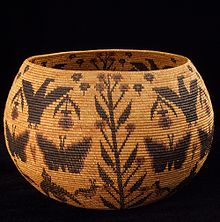 Native American basket weaving is one of the oldest forms of crafts in history. Archaeologists say the origins of Native American basket weaving in the Southwest can be traced back nearly eight-thousand years. Like most other customs and cultures, basket weaving involved different patterns, materials, shapes and techniques among different tribes. Native American basket weaving and American Indian pottery has a long and storied past and the traditions of both are more than just relevant today.
Native American basket weaving is one of the oldest forms of crafts in history. Archaeologists say the origins of Native American basket weaving in the Southwest can be traced back nearly eight-thousand years. Like most other customs and cultures, basket weaving involved different patterns, materials, shapes and techniques among different tribes. Native American basket weaving and American Indian pottery has a long and storied past and the traditions of both are more than just relevant today.
Native American Basket Weaving
The history of basket weaving can truly be traced back to the beginning of mankind. Native American basket weaving designs varied among tribes and was created from different environmental elements that existed in different regions. Sea grasses, swamp ash, black ash, sweet grass, birch bark, split river cane, and spruce root have all been used in Native American basket weaving. The baskets were originally designed for utilitarian purposes,
Far from a forgotten form of art, the tradition of Native American basket weaving continues today. Modern artists use present-day techniques while still creating traditional designs. In fact, the California Indian Basketweavers Association has been holding a popular gathering every year since 1991. Some colleges even offer a course dedicated to Native American basket weaving.
American Indian Pottery
In addition to Native American basket weaving, another very popular form of art is American Indian pottery. Originally, the pottery was used for cooking, storage and transporting goods. In fact, art was likely the last thing on the mind of someone creating American Indian pottery in the past. Like Native American basket weaving, American Indian pottery has different styles and designs based on the customs and cultural diversity of tribes. Tribes located in the Southwestern United States, such as the Hopi and Zuni, are all widely renowned for their types and styles of painted pottery.